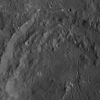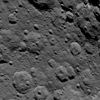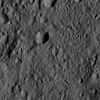Loading AI tools
From Wikipedia, the free encyclopedia
Ceres is a dwarf planet in the asteroid belt that lies between the orbits of Mars and Jupiter. The IAU has adopted two themes for naming surface features on Ceres: agricultural deities for craters and agricultural festivals for everything else.[1]

As of 2020, the IAU has approved names for 151 geological features on Ceres: craters, montes, catenae, rupēs, plana, tholi, planitiae, fossae and sulci.[2][3] In July 2018, NASA released a comparison of physical features found on Ceres with similar ones present on Earth.[4]
Piazzi, named after Giuseppe Piazzi, the discoverer of Ceres, is a dark region southwest of Dantu crater in ground-based images that was named before Dawn arrived at Ceres.[5]

| Feature | Named after | Diameter (km) | Image |
|---|---|---|---|
| Baltay Catena | Baltai, a Mordvin (Mordvinian) agricultural festival in the Volga River region of Russia[6] | 83.5 | |
| Gerber Catena | Gerber, a Udmurt (Volga-Ural region, Russia) agricultural festival after the spring sowing in June[7] | 100 |  |
| Junina Catenae | Festa Junina, Brazilian festival with a rural theme held in June at the end of the rainy season to give thanks for fertile rain[8] | 263 | |
| Pongal Catena | Thai Pongal, Tamil harvest festival observed in mid-January, a time to give thanks to nature[9] | 95.5 | |
| Samhain Catenae[a] | Samhain, the Gaelic festival at the end of the harvest season, which was observed in Ireland and Scotland during seven days in October and November, nearly halfway between the autumn equinox and the winter solstice[10] | 715 |  |
| Uhola Catenae | Uhola, a Nigerian (Zuru) harvest festival[11] | 400 |  |
Ceres is saturated with impact craters. Many have a central pit or bright spot.
In the first batch of 17 names approved by the IAU, craters north of 20° north latitude had names beginning with A–G (with Asari being the furthest north), those between 20° north and south latitude beginning with H–R, and those further south beginning with S–Z (with Zadeni being the furthest south).

| Feature | Named after | Diameter (km) | Image |
|---|---|---|---|
| Abellio | Abellio, Gaul (Celtic) god of the apple tree[12] | 32 |  |
| Achita | Achita, a Tiv god of agriculture[13] (Close-up Image-1) | 40 |  |
| Annona | Annona, Roman goddess of crops and of the harvest[14] | 60 |  |
| Anura | Anura, a Arawak (Guyana) spirit of the tobacco seeds[15] | 37 | |
| Aristaeus | Aristaeus, Greek god of agriculture[16] | 35.8 | |
| Asari | Asari, an Assyrian god of agriculture[17] (in the image at right, Asari is just above center) |
56 |  |
| Attis | Attis, Greek and Phrygian god of vegetation and of fertility[18] | 22 |  |
| Axomama | Axomamma, an Incan goddess of potatoes[19] | 5 | |
| Azacca | Azaka Medeh, Haitian loa of agriculture[20] (Close-up Image-1; Close-up Image-2) | 49.91 |  |
| Begbalel | Bagbalel, a Yapese guardian of the taro fields who controls the yield of the crops[21] | 102 | |
| Belun | Belun, a Belarusian god of the fields[22] | 36.04 | |
| Besua | Besuā, a minor Egyptian grain god[23] | 17 |  |
| Bilwis | Bilwis, a German corn spirit[24] | 7 | |
| Binayo | Binayo, a Mangyan female spirit, caretaker of rice spirits[25] | 16 | |
| Bonsu | Bonsu, a Batek god who watches over the fruits and flowers[26] | 31 | |
| Braciaca | Celtic mythology god of malt[27] | 8 | |
| Cacaguat | Nicaraguan god of cacao[28] | 13.6 | |
| Centeotl | Centeotl, Aztec god of maize and agriculture[29] | 6 |  |
| Chaminuka | Shona (Zimbabwe) spirit who provides rains in times of droughts[30] (Close-up Image) | 122 |  |
| Coniraya | Coniraya, Inca lunar deity responsible for agricultural terracing and irrigation[31] | 135 |  |
| Consus | Consus, ancient Roman agricultural god who watched over the harvested and stored crop.[32] | 64 |  |
| Cozobi | Cozobi, Zapotec (south Mexico) god of maize and of abundant food[33] | 24 | |
| Dada | Nigerian god of vegetables[34] | 12 | |
| Damia | Greek goddess of the cornfields and crops[35] | 7 | |
| Dantu | Dantu, Ga god associated with the planting of grain[36] (Close-up Image-1; Close-up Image-2; Close-up Image-3; Close-up Image-4) | 126 |  |
| Darzamat | Dārza māte; Latvian deity, 'mother of the garden'[37] | 92 |  |
| Datan | Polish god of the tilling of the soil[38] (Close-up Image-1; Close-up Image-2; Close-up Image-3; Close-up Image-4; Close-up Image-5) | 60 |  |
| Dikhan | Dikhan baba; Kazakh pre-Islamic deity of farming[39] | 21 | |
| Doliku | Dahomeyan (Benin) god of the fields[40] | 15 | |
| Duginavi | Kogi (northern Colombia) god who taught people agriculture[41] | 155 | |
| Emesh | Sumerian god of vegetation and agriculture[42] | 20 | |
| Enkimdu | Sumerian god of farming[43] | 9 | |
| Ernutet | Ernutet, Egyptian cobra-headed goddess of the harvest[44] (Close-up Image-1; Close-up Image-2; Close-up Image-3 / organics detected[45]) | 53.4 |  |
| Ezinu | Sumerian goddess of grain[46] (Close-up Image-1; Close-up Image-2; Close-up Image-3; Close-up Image-4; Close-up Image-5) | 116 |  |
| Fejokoo | Aboh (Igbo) deity who provided the yam[47] (in the image at right, Fejokoo is just right of center) (Close-up Image) |
68 |  |
| Fluusa | Oscan (ancient southern Italy) goddess of flowers, counterpart of the Roman goddess Flora. | 60 |  |
| Gaue | Germanic goddess to whom offerings are made for the rye harvest[48] (Close-up Image-1; Close-up Image-2; Close-up Image-3) | 80 |  |
| Geshtin | Sumerian goddess of the grapevine and wine[49] (Close-up Image) | 80 |  |
| Ghanan | Chanan, Tzeltal god of maize[50] (Close-up Image-1; Close-up Image-2; Close-up Image-3) | 68 |  |
| Hakumyi | Paraguayan, Brazilian and Bolivian spirit helpful in gardening[51] | 29.2 | |
| Hamori | Japanese god, protector of tree leaves[52] (Close-up Image) | 60 |  |
| Hatipowa | Indian god of agriculture[53] | 40 | |
| Haulani | Hau-lani, Hawaiian plant goddess[54] (Context Image) | 34 |  |
| Heneb | Early Egyptian god of grain, produce and vineyards[55] | 39 | |
| Homshuk | Sierra Popoluca (south Mexico) spirit of corn (maize)[56] | 70 |  |
| Ialonus | Ialonus, Celtic (British) god of the cultivated field and of the meadows[57] | 16.5 | |
| Ikapati | Lakapati or Ikapati, Tagalog goddess of the cultivated lands[58] (Close-up Image-1; Close-up Image-2; Close-up Image-3; Close-up Image-4; Close-up Image-5) | 50 |  |
| Inamahari | One of a pair (male and female) of Siouan (South Carolina, perhaps Catawba) deities invoked for success at the sowing season[59] | 68 | |
| Inkosazana | Inkosazana, the Zulu agricultural goddess[60] | 40 | |
| Insitor | Insitor, helper god of Ceres and Roman agricultural deity in charge of the sowing[61] | 26 | |
| Jacheongbi | Jacheongbi,korean goddess of agriculture in jeju who is said to have brought 5 grains to the island.[62] | 31 | |
| Jaja | Abkhaz harvest goddess[63] | 22 |  |
| Jarimba | Yarimba, Antakirinya (Australia) god of flowers and fruit[64] | 69 |  |
| Jarovit | Jarovit (Yarovit), proto-Slavic god of fertility and harvest, who comes down to the Underworld after each harvest and returns each spring[65] (Close-up Image-1; Closeup Image-2) | 66 |  |
| Juling | Orang Asli (formerly also called Sakai people, now a term for separate and distinct group)/ (Malaysia) spirit of the crops[66] (Close-up Image) | 20 |  |
| Jumis | Jumis,Latvian god of fertility of the field.[67] | ||
| Kahukura | Kahukura,Maori god of kumara(sweet potato) crops.[68] | 6.3 | |
| Kaikara | Konjo and Banyoro (Uganda) goddess of harvest[69] | 72 |  |
| Kait | Hattic goddess of grain (Asia Minor). Defines zero degrees longitude on Ceres[70] | 0.4 | |
| Kaneki | Micronesian (Pohnpei/Ponape Island, Caroline Islands) god of the coconut palm[71] | 31.5 | |
| Kerwan | Hopi spirit of the sprouting maize[72] (Close-up Image) | 280 |  |
| Kiriamma | Veddan (Sri Lanka) goddess and provider of food ('milk mother')[73] | 18.7 | |
| Kirnis | Kirnis, Lithuanian spirit and guardian of cherry trees[74] (in the image at right, Kirnis is near the terminator at 4 o'clock from the bright spots) (Close-up Image-1; Close-up Image-2) |
115 |  |
| Kokopelli | Pueblo fertility deity who presides over agriculture[75] | 34 | |
| Kondos | Finnish agricultural deity[76] | 44 |  |
| Kumitoga [kumiˈtoŋa] |
Kumitoga (Kumitonga), Tuamotuan goddess of feasting mats and one of three goddesses of plant life[77] | 96 | |
| Kupalo | Russian (Slavic) god of vegetation and of the harvest[78] (Close-up Image-1; Close-up Image-2; Close-up Image-3) | 26 |  |
| Laukumate | Latvian spirit, 'mother of the fields'[79] | 29.7 |  |
| Liber | Liber, Roman god of agriculture[80] (Close-up Image) | 23 |  |
| Lociyo | Zapotec (Mexico) deity to whom a ceremony is performed when the first chilli plant is cut[81] | 37.8 | |
| Lono | Lono, Hawaiian god of agriculture[82] (Close-up Image) | 20 |  |
| Meanderi | Ngaing (New Guinea) goddess of taro, sugar cane and other foods[83] (Close-up Image) | 103 |  |
| Megwomets | Yurok (California) dwarf god of acorns and distributor of vegetal abundance[84] | ||
| Messor | Messor, helper god of Ceres and Roman god of harvesting, of cutting of the grain[85] (Close-up Image-1; Close-up Image-2; Close-up Image-3) | 40 |  |
| Mlezi | Name of god Tilo as "Food-Giver" (Tonga tribes of Malawi and Zambia)[86] | 41.5 | |
| Mondamin | Ojibwe corn (maize) god (Lake Superior area, Canada and the United States)[87] (Close-up Image-1; Close-up Image-2; Close-up Image-3; Close-up Image-4; Close-up Image-5) | 126 |  |
| Nawish | Acoma guardian of the field[88] | 77 |  |
| Nepen | Egyptian god of rain[89] | 26.4 | |
| Ninsar | Ninsar, Sumerian goddess of plants and vegetation[90] | 40 |  |
| Nunghui | Canelos Quichua (Ecuador) female spirit of garden soil and pottery clay[91] | 22 | |
| Occator | Occator, helper god of Ceres and Roman agricultural deity of the harrowing.[92] "Region A" in ground-based images (Close-up Image-1; Close-up Image-2; Close-up Image-3; Close-up Image-4; Close-up Image-5; Close-up Image-6; Close-up Image-7; Close-up Image-8; Close-up Image-9; Close-up Image-10; Close-up Image-11; Close-up Image-12) | 92 |  |
| Oltagon | Philippine agricultural goddess[93] | 28 | |
| Omonga | Mori (Tomori) rice spirit that dwells in the Moon[94] (Close-up Image) | 77 |  |
| Oxo /ˈɒʃoʊ/ |
Candomblé (and Yoruba) god of agriculture[95] (Context Image; Close-up Image - "Water-Ice" Detected; Close-up Image) | 10 |  |
| Peko | Seto (southeast Estonia) fertility god[96] | 11 | |
| Piuku | Carib (Barama River, Guyana) god of the manioc[97] | 31 |  |
| Rao | Mangarevan god involved in the planting of turmeric[98] (Close-up Image) | 12 |  |
| Ratumaibulu | Fijian serpent god of agriculture and the underworld[99] | 20 | |
| Razeka | Arabian tribal god worshipped as the provider of food[100] | 38.38 | |
| Rongo | Rongo, Maori god of cultivation[101] (Close-up Image) | 68 |  |
| Roskva | Teutonic goddess who symbolises the ripe fields of harvest[102] | 22 |  |
| Sekhet | Egyptian name of Isis as goddess of cultivated lands and fields[103] (Close-up Image) | 41 |  |
| Shakaema | Shakaëma, Jivaro (Ecuador and Peru) god of vegetation invoked in the planting and cultivation of bananas[104] | 49 | |
| Shennong | Shennong, Chinese buffalo-headed deity of agriculture[105] | 32.5 | |
| Sintana | Kogi deity who produced fertile black earth[106] (Close-up Image-1; Close-up Image-2; Close-up Image-3) | 61 |  |
| Tafakula | Tongan (Polynesia) goddess invoked for favourable seasons for the crops[107] | 34 | |
| Tahu | Maori (New Zealand) personification of all food[108] | 25 | |
| Takel | Yak Takel, Semang goddess of the tuber harvest[109] (Close-up Image) | 21 |  |
| Tawals | Polish god of the fields and of the tilling[110] | 8.8 | |
| Telepinu | Telepinu Hittite god of fertility and vegetation[111] | 31 | |
| Thrud | Scandinavian goddess who "signifies the seed"[112] | 7.8 | |
| Tibong | Land Dayak (Borneo) malevolent spirit who devours and depletes the rice[113] | 37 |  |
| Toharu | Pawnee god of food and vegetation[114] (Close-up Image) | 87 |  |
| Tupo | An obscure Mangarevan god of disorder (perhaps the same as Tu or Tupa), involved in turmeric planting[115] (Close-up Image-1; Close-up Image-2) | 37 | 
|
| Urvara | Ancient titular deity of plants (Iranian) and fertile fields (Indian)[116] (Close-up Image-1; Close-up Image-2; Close-up Image-3; Close-up Image-4; Close-up Image-5) | 163 |  |
| Victa | Roman goddess of food and nourishment[117] | 30 |  |
| Vinotonus | Britonic (Celtic) god of the vine (wine)[118] | 140 |  |
| Xevioso | Fon (Benin/Dahomey) god of thunder and fertility[119] | 8.5 | |
| Xochipilli | Xochipilli, Aztec fertility god associated with maize and flowers; patron of music and dance[120] | 22.7 | |
| Yalode | Dahomeyan goddess worshipped by women at harvest rites[121] (Close-up Image-1; Close-up Image-2; Close-up Image-3; Close-up Image-4; Close-up Image-5; Close-up Image-6; Close-up Image-7) | 260 |  |
| Zadeni | Zadeni, ancient Georgian god of bountiful harvests[122] (Close-up Image-1; Close-up Image-2; Close-up Image-3) | 129.28 |  |
| Zatik | Armenian god of fertility and vegetation[123] | 4 |
A few of the brightest faculae were numbered during the approach of the Dawn spacecraft.
| Feature | Named after | Number | Location | Image |
|---|---|---|---|---|
| Cerealia Facula | Cerealia, Ancient Roman festival of the grain goddess Ceres | 5 | Occator crater (center) |  |
| Pasola Facula | Pasola, rice-planting festival on Sumba Island | 5 | Occator crater (center) | |
| Vinalia Faculae | Vinalia, Roman wine festivals | 5 | Occator crater (east) |
| Feature | Named after | Diameter (km) | Image |
|---|---|---|---|
| Makahiki Labyrinthus | Makahiki, Hawaiian harvest festival | 22 |
| Feature | Named after | Diameter (km) | Image |
|---|---|---|---|
| Ahuna Mons /əˈhuːnə/ | Ahuna, the Sumi (Nagaland, northeast India) traditional post-harvest festival that signifies the celebration of the season's harvest's thanksgiving[125] (Close-up Image) | 20 |  |
| Liberalia Mons /lɪbərˈeɪliə/ | Liberalia, ancient Roman festival to honour Liber and Libera, deities of the vine, worshipped, along with Ceres as fertility gods, held on 17 March[126] | 90 | |
| Yamor Mons[b] /ˈjæmɔːr/ | Yamor, an Ecuadorean maize festival[127] | 17 |
The three planitiae may be large and largely obliterated craters.
| Feature | Named after | Diameter (km) | Image |
|---|---|---|---|
| Vendimia Planitia /vɛnˈdɪmiə/ | The Fiesta Nacional de la Vendimia grape-harvest festival in Mendoza, Argentina during the first week of March, one of the most important festivals in the country[129] | 800 |
| Feature | Named after | Diameter (km) | Image |
|---|---|---|---|
| Niman Rupes | Hopi (southwestern United States) ritual ending the kachina (spiritual beings) season, celebrating the kachinas' return to their spiritual home in July and their part in the blossoming of plant life[130] (Related Image) | 45 |
| Feature | Named after | Diameter (km) | Image |
|---|---|---|---|
| Nar Sulcus | Azerbaijani festival of the pomegranate harvest, held October–November in Goychay, the centre of pomegranate cultivation in the country[131] | 63 |
| Feature | Named after | Diameter (km) | Image |
|---|---|---|---|
| Aymuray Tholi | Quechua (Peru) harvest festival in May, meaning 'the song of the harvest'[132] | 81 | |
| Bagach Tholus | Bagach(Багач), Belarusian harvest festival held on the 21st of September[133] | 4.3 | |
| Cerealia Tholus | Cerealia,the major festival in Ancient Rome to celebrate the grain goddess Ceres (8 days in mid- to late-April)[134] | 3.2 | |
| Cosecha Tholus | Colombian harvest festival (Fiestas de la Cosecha), held in August in Pereira[135] | 50 | |
| Dalien Tholus | Bon Dalien, Khmer (Cambodian) festival at the end of the rice harvest (January to February)[136] | 22 |  |
| Hosil Tholus | Hosil bayrami, Uzbek (Central Asia) cotton harvest festival[137] | 31 | |
| Kekri Tholus | Kekri, a Finnish festival held on the first Saturday of November.[138] | 4.6 | |
| Kwanzaa Tholus | Kwanzaa, African-American festival based on ancient African harvest festivals (from 26 December to 1 January)[139] | 48 | |
| Lohri Tholus | Lohri, Punjabi harvest festival on January 13.[140] | 3.8 | |
| Lughnasa Tholus | Lughnasa Celtic harvest festival traditionally celebrated on August 1[141] | 35.87 | |
| Mikeli Tholus | Miķeļi, Latvian harvest festival held at the end of September (the autumn equinox)[142] | 37 | |
| Wangala Tholus | Wangala, Garo people (Meghalaya and Assam states, northeast India and Bangladesh) post-harvest three-day festival that marks the end of the agricultural year (November)[143] | 50 |
Seamless Wikipedia browsing. On steroids.
Every time you click a link to Wikipedia, Wiktionary or Wikiquote in your browser's search results, it will show the modern Wikiwand interface.
Wikiwand extension is a five stars, simple, with minimum permission required to keep your browsing private, safe and transparent.